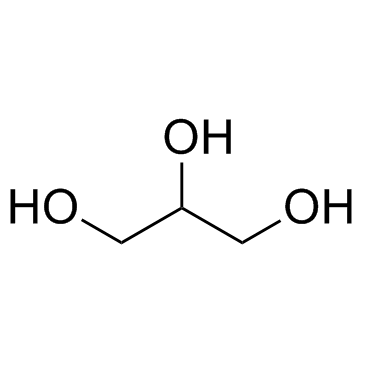
Glycerol
CAS No. 56-81-5
Glycerol( Glycerin )
Catalog No. M19631 CAS No. 56-81-5
Glycerol or glycerin is a colourless odourless viscous liquid that is sweet-tasting and mostly non-toxic. It is widely used in the food industry as a sweetener and humectant and in pharmaceutical formulations.
Purity : >98% (HPLC)
 COA
COA
 Datasheet
Datasheet
 HNMR
HNMR
 HPLC
HPLC
 MSDS
MSDS
 Handing Instructions
Handing Instructions
| Size | Price / USD | Stock | Quantity |
| 100MG | Get Quote | In Stock |


|
| 200MG | Get Quote | In Stock |


|
| 500MG | Get Quote | In Stock |


|
| 1G | Get Quote | In Stock |


|
Biological Information
-
Product NameGlycerol
-
NoteResearch use only, not for human use.
-
Brief DescriptionGlycerol or glycerin is a colourless odourless viscous liquid that is sweet-tasting and mostly non-toxic. It is widely used in the food industry as a sweetener and humectant and in pharmaceutical formulations.
-
DescriptionGlycerol or glycerin is a colourless odourless viscous liquid that is sweet-tasting and mostly non-toxic. It is widely used in the food industry as a sweetener and humectant and in pharmaceutical formulations. Glycerol is an important component of triglycerides (i.e. fats and oils) and of phospholipids. Glycerol is a three-carbon substance that forms the backbone of fatty acids in fats. When the body uses stored fat as a source of energy glycerol and fatty acids are released into the bloodstream. The glycerol component can be converted into glucose by the liver and provides energy for cellular metabolism. Normally glycerol shows very little acute toxicity and very high oral doses or acute exposures can be tolerated. On the other hand chronically high levels of glycerol in the blood are associated with glycerol kinase deficiency (GKD). GKD causes the condition known as hyperglycerolemia an accumulation of glycerol in the blood and urine. There are three clinically distinct forms of GKD: infantile juvenile and adult. The infantile form is the most severe and is associated with vomiting lethargy severe developmental delay and adrenal insufficiency. The mechanisms of glycerol toxicity in infants are not known but it appears to shift metabolism towards chronic acidosis. Acidosis typically occurs when arterial pH falls below 7.35. In infants with acidosis the initial symptoms include poor feeding vomiting loss of appetite weak muscle tone (hypotonia) and lack of energy (lethargy). These can progress to heart liver and kidney abnormalities seizures coma and possibly death. These are also the characteristic symptoms of untreated GKD. Many affected children with organic acidemias experience intellectual disability or delayed development. Patients with the adult form of GKD generally have no symptoms and are often detected fortuitously.
-
In Vitro——
-
In Vivo——
-
SynonymsGlycerin
-
PathwayProteasome/Ubiquitin
-
TargetEndogenous Metabolite
-
RecptorEndogenous Metabolite
-
Research AreaOthers
-
IndicationConstipation cerebral edema
Chemical Information
-
CAS Number56-81-5
-
Formula Weight92.09
-
Molecular FormulaC3H8O3
-
Purity>98% (HPLC)
-
SolubilityDMSO:≥300 mg/mL (3257.68 mM);Water:>500mg/ml
-
SMILESOCC(O)CO
-
Chemical Namepropane-123-triol
Shipping & Storage Information
-
Storage(-20℃)
-
ShippingWith Ice Pack
-
Stability≥ 2 years
Reference
1.Sweatman B C Farrant R D Holmes E et al. 600 MHz 1H-NMR spectroscopy of human cerebrospinal fluid: effects of sample manipulation and assignment of resonances.[J]. Journal of Pharmaceutical & Biomedical Analysis 1993 11(8):651-64.
molnova catalog



related products
-
7,8-Dihydro-L-biopte...
7,8-Dihydro-L-biopterin is an oxidation product of tetrahydrobiopterin.
-
Carveol
(-)-Carveol, mixture of isomers is a monocyclic monoterpenic alcohol, present in essential oils of plant species such as Cymbopogon giganteus, Illicium pachyphyllum and in spices such as Carum carvi (cumin).
-
cis-4-Hydroxy-L-prol...
cis-4-Hydroxy-L-proline is an inhibitor of the synthesis and extracellular deposition of collagen. cis-4-Hydroxy-L-proline could inhibit fibroblast growth by preventing the deposition of triple-helical collagen on the cell layer.



 Cart
Cart
 sales@molnova.com
sales@molnova.com


